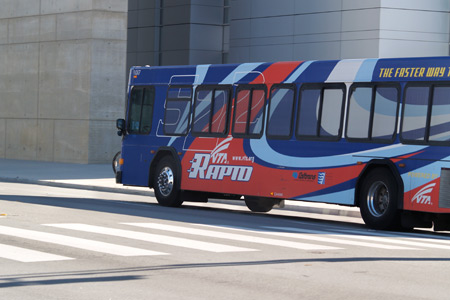
February 8, 2010 – Based in Santa Clara, the Valley Transportation Authority (VTA) serves the transit needs of six municipalities. Their bus and light-rail lines have seen significant increases in ridership each of the past five years, and VTA has continued studying and implementing improvement programs to better serve their growing number of riders.
One study in particular examined the increase in average operating speed provided by the Intelligent Transportation System (ITS) application of Bus Signal Priority (BSP) in rapid bus operation as compared to traditional local bus operation. This study evaluated two methods of signal priority, an in-ground loop and detector system and an EMTRAC GPS and RF-based vehicle detection system.
The study noted that signal priority enabled the operation of rapid bus service with reduced stops and more liberal operating rules than local service. Buses receiving priority traveled 18.4 percent faster than those without priority. Further, buses receiving priority using the EMTRAC system traveled 23 percent faster than those without priority.
Another advantage the EMTRAC system offers is that there is no need to bury in-ground loops, enabling municipalities to improve on-time bus performance without requiring costly sub-surface installations.
From a financial standpoint, public transit has few opportunities to implement productivity improvements. The approximately 20 percent gains from Bus Signal Priority are very important to transit agencies from a resource-allocation perspective. An improvement of 20 percent equates to an effective operating savings for VTA of nearly $1 million annually. Since 2005, operating and maintenance costs for the BSP elements have been negligible, with no equipment failures encountered since installation. Capital costs for BSP average less than $10,000 per intersection and $3,000 per bus.
The use of Bus Signal Priority in combination with other BRT features has proven to have the desired effect on vehicle operations, and thus fulfills the goals of ITS projects. Not only are the results statistically significant, but rider gains in the corridor also accompany the perceived improvement in service quality by the public.
VTA’s experience with BSP is similar to that of other transit agencies across the nation. Bus Signal Priority is one of the few cost effective tools available to public transit agencies that improve productivity without adverse consequences. BSP is a foundation element for VTA’s extensive Bus Rapid Transit planning effort, and it is likely that BSP will will be a major component of transit operations industry-wide in the near future.
